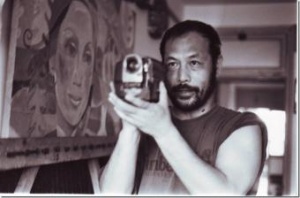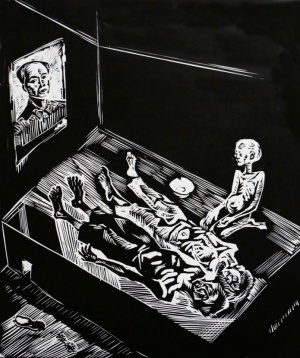“Hu Jie”的版本间的差异
来自China Digital Space
小 (文本替换 - 替换“Category”为“分类”) |
|||
| (未显示另一用户的1个中间版本) | |||
| 第10行: | 第10行: | ||
''Then you briefly worked for Xinhua, the state news agency.'' | ''Then you briefly worked for Xinhua, the state news agency.'' | ||
| − | [[File:HuJie-woodblock.jpg|300px|right|thumb|''Woodblock print displaying a scene from the Great Famine | + | [[File:HuJie-woodblock.jpg|300px|right|thumb|''Woodblock print displaying a scene from the Great Famine ([https://shenzhennoted.com/tag/hu-jie/ Shenzhen Noted])'']]It was an interesting job. I was hired to make short documentary films. You could film corrupt officials. They would have just been arrested and you could go to the prison and interview them. They’d open their hearts to you, crying and weeping. Once I was sent to a village to interview a village chief. The village party secretary was beaten up by thugs and told to follow their orders. You saw things like that. But then I think they knew I was filming other things on my own, and I was asked to leave. [[http://www.nybooks.com/daily/2015/05/27/chinas-invisible-history-hu-jie/ '''Source]'''] </blockquote> |
In addition to films, Hu also continues to make oil paintings and hand-carved woodblock prints, which sometimes topically supplement his films. In 2014, the year that "Spark" debuted, Hu created a series of woodblock prints depicting scenes from the Great Chinese Famine. The prints were to form an exhibition in Tianjin that was cancelled. The blockprints did go on [https://mp.weixin.qq.com/s?__biz=MjM5NDM2NzYxMw==&mid=211774920&idx=1&sn=f7d847ae129f043eecdeef2d4b25aea6&scene=1&srcid=0914QkYSE53ZPASo15Cx5PH2&key=dffc561732c22651f58b8c7ae69b873bedde6ea621dea87ad84fbc412278c6a29f97c6d279921d82534d4ac1ca321c22&ascene=0&uin=MTAwMzE4ODAyNg==&devicetype=iMac%20MacBookPro11,3%20OSX%20OSX%2010.10.5%20build(14F27)&version=11020201&pass_ticket=Ky5KbIRsrYb%20h1aBhKC22GIAFhKpNp/eY%20q72Nb6rMXOEwLrlJg6hKqvRpiE8K3a public display in China in 2015, during a weeklong exhibition in Guangzhou]. | In addition to films, Hu also continues to make oil paintings and hand-carved woodblock prints, which sometimes topically supplement his films. In 2014, the year that "Spark" debuted, Hu created a series of woodblock prints depicting scenes from the Great Chinese Famine. The prints were to form an exhibition in Tianjin that was cancelled. The blockprints did go on [https://mp.weixin.qq.com/s?__biz=MjM5NDM2NzYxMw==&mid=211774920&idx=1&sn=f7d847ae129f043eecdeef2d4b25aea6&scene=1&srcid=0914QkYSE53ZPASo15Cx5PH2&key=dffc561732c22651f58b8c7ae69b873bedde6ea621dea87ad84fbc412278c6a29f97c6d279921d82534d4ac1ca321c22&ascene=0&uin=MTAwMzE4ODAyNg==&devicetype=iMac%20MacBookPro11,3%20OSX%20OSX%2010.10.5%20build(14F27)&version=11020201&pass_ticket=Ky5KbIRsrYb%20h1aBhKC22GIAFhKpNp/eY%20q72Nb6rMXOEwLrlJg6hKqvRpiE8K3a public display in China in 2015, during a weeklong exhibition in Guangzhou]. | ||
| 第24行: | 第24行: | ||
*[https://chinadigitaltimes.net/chinese/search_gcse/?q=胡杰 中文] | *[https://chinadigitaltimes.net/chinese/search_gcse/?q=胡杰 中文] | ||
| − | [[ | + | [[分类:People]] |
2023年8月7日 (一) 05:01的最新版本
Hú Jié | 胡杰

Born in 1958 in Jinan, Shandong, Hu Jie is an artist and filmmaker known for making documentaries on the policy excesses of the Mao era, none of which have been publicly screened in China due to their politically sensitive nature. He is best known for a trilogy of documentaries he made between 2004 and 2013, consisting of "Searching for Lin Zhao's Soul" (寻找林昭的灵魂) (2004), "Though I Am Gone" (我虽死去) (2006), and "Spark" (星火) (2013). The latter film, which focused on a group of students who were arrested after publicizing officials' conduct during the Great Chinese Famine (1959-1961) won top prize at the 2014 Taiwan International Documentary Festival.
Prior to beginning his career as a filmmaker, Hu Jie received a degree in oil painting from the Art College of the People's Liberation Army in Beijing, and after graduation served in the PLA for 15 years. After his service, Hu began to travel China with his camera, before briefly working as a video journalist for Xinhua News Agency. In a 2015 interview with The New York Review of Books' Ian Johnson, Hu described his introduction to documentary filmmaking and his short stint with Xinhua:
After you left the PLA in 1992, you began to wander around China quite a bit. You lived in the Old Summer Palace and began to film.
Not too many people were making documentary films then. In fact, almost no one. Back then, you couldn’t even find a book on how to make documentary films. I felt that the problems in society were so serious, but the media was just broadcasting propaganda. There was such a gap. I thought then: Why don’t those journalists tell the truth? Then I thought: Why don’t you try yourself, try to say something true? A friend who had returned from Japan had a Super 8 camera and I bought it. So I left with a camera and traveled. I went to Qinghai. I went to mines. I made a lot of films. Everything was at the grassroots. I stayed with people so poor they had nothing.
Then you briefly worked for Xinhua, the state news agency.
 Woodblock print displaying a scene from the Great Famine (Shenzhen Noted)
Woodblock print displaying a scene from the Great Famine (Shenzhen Noted)It was an interesting job. I was hired to make short documentary films. You could film corrupt officials. They would have just been arrested and you could go to the prison and interview them. They’d open their hearts to you, crying and weeping. Once I was sent to a village to interview a village chief. The village party secretary was beaten up by thugs and told to follow their orders. You saw things like that. But then I think they knew I was filming other things on my own, and I was asked to leave. [Source]
In addition to films, Hu also continues to make oil paintings and hand-carved woodblock prints, which sometimes topically supplement his films. In 2014, the year that "Spark" debuted, Hu created a series of woodblock prints depicting scenes from the Great Chinese Famine. The prints were to form an exhibition in Tianjin that was cancelled. The blockprints did go on public display in China in 2015, during a weeklong exhibition in Guangzhou.




